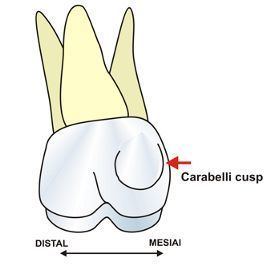Latin tuberculum anomale FMA 74035 | TA A05.1.03.071 | |
 | ||
The cusp of Carabelli, or Carabelli's tubercle, or tuberculum anomale of Georg Carabelli is a small additional cusp at the mesiopalatal line angle of maxillary first molars. This extra cusp is usually found on the first molar, and becomes progressively less likely in the second, third molars. This cusp is entirely absent in some individuals and present in others in a variety of forms. In some cases, Carabelli's cusp may rival the main cusps in size. Other related forms include ridges, pits, or furrows. This additional cusp was first described in 1842 by the Hungarian Georg Carabelli (Carabelli György), the court dentist of the Austrian Emperor Franz.
The cusp of Carabelli is a heritable feature. Kraus (1951) proposed that homozygosity of a gene is responsible for a pronounced tubercle,whereas the heterozygote shows slight grooves, pits, tubercles or bulge. Later studies showed that the development of this trait is affected by multiple genes. Carabelli's cusp is most common among Europeans (75-85% of individuals) and rarest in Pacific Islands (35-45%).
